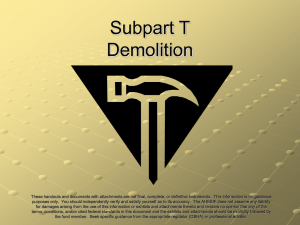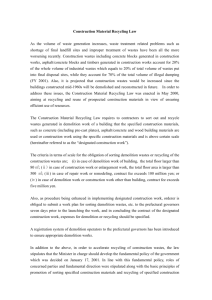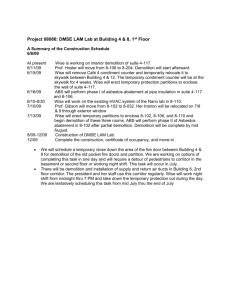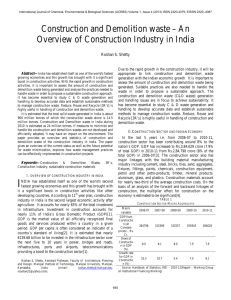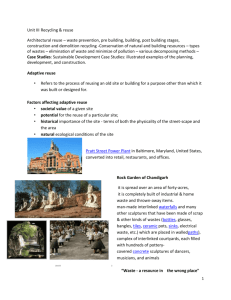B220130609 - American Journal of Engineering Research
advertisement
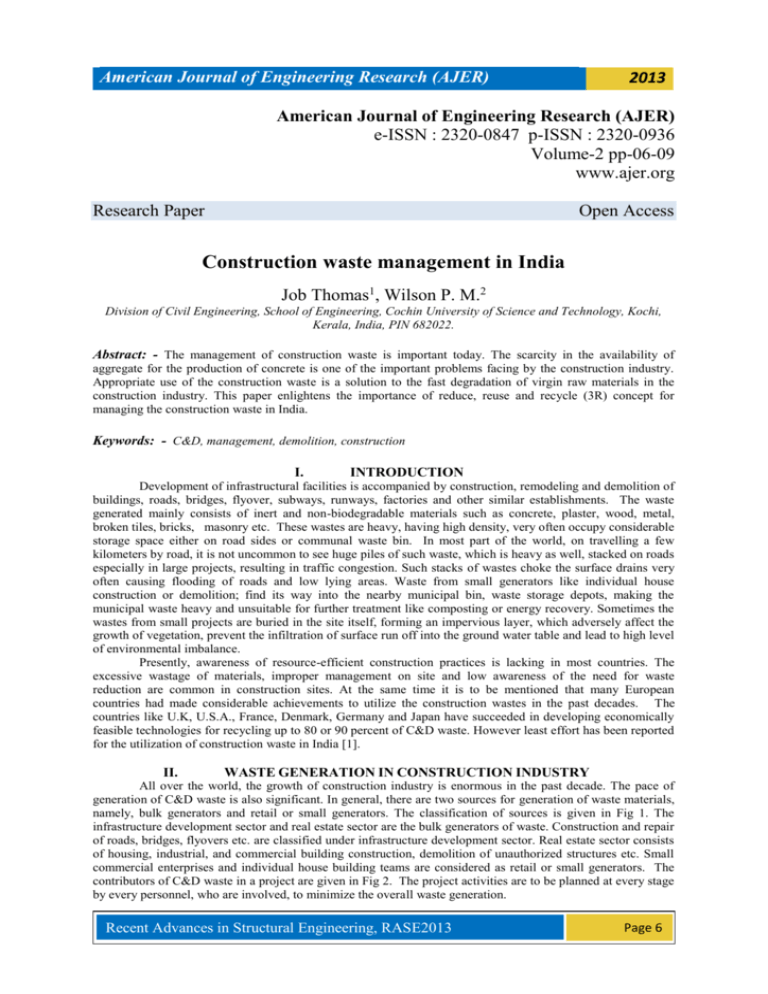
2013 American Journal of Engineering Research (AJER) American Journal of Engineering Research (AJER) e-ISSN : 2320-0847 p-ISSN : 2320-0936 Volume-2 pp-06-09 www.ajer.org Research Paper Open Access Construction waste management in India Job Thomas1, Wilson P. M.2 Division of Civil Engineering, School of Engineering, Cochin University of Science and Technology, Kochi, Kerala, India, PIN 682022. Abstract: - The management of construction waste is important today. The scarcity in the availability of aggregate for the production of concrete is one of the important problems facing by the construction industry. Appropriate use of the construction waste is a solution to the fast degradation of virgin raw materials in the construction industry. This paper enlightens the importance of reduce, reuse and recycle (3R) concept for managing the construction waste in India. Keywords: - C&D, management, demolition, construction I. INTRODUCTION Development of infrastructural facilities is accompanied by construction, remodeling and demolition of buildings, roads, bridges, flyover, subways, runways, factories and other similar establishments. The waste generated mainly consists of inert and non-biodegradable materials such as concrete, plaster, wood, metal, broken tiles, bricks, masonry etc. These wastes are heavy, having high density, very often occupy considerable storage space either on road sides or communal waste bin. In most part of the world, on travelling a few kilometers by road, it is not uncommon to see huge piles of such waste, which is heavy as well, stacked on roads especially in large projects, resulting in traffic congestion. Such stacks of wastes choke the surface drains very often causing flooding of roads and low lying areas. Waste from small generators like individual house construction or demolition; find its way into the nearby municipal bin, waste storage depots, making the municipal waste heavy and unsuitable for further treatment like composting or energy recovery. Sometimes the wastes from small projects are buried in the site itself, forming an impervious layer, which adversely affect the growth of vegetation, prevent the infiltration of surface run off into the ground water table and lead to high level of environmental imbalance. Presently, awareness of resource-efficient construction practices is lacking in most countries. The excessive wastage of materials, improper management on site and low awareness of the need for waste reduction are common in construction sites. At the same time it is to be mentioned that many European countries had made considerable achievements to utilize the construction wastes in the past decades. The countries like U.K, U.S.A., France, Denmark, Germany and Japan have succeeded in developing economically feasible technologies for recycling up to 80 or 90 percent of C&D waste. However least effort has been reported for the utilization of construction waste in India [1]. II. WASTE GENERATION IN CONSTRUCTION INDUSTRY All over the world, the growth of construction industry is enormous in the past decade. The pace of generation of C&D waste is also significant. In general, there are two sources for generation of waste materials, namely, bulk generators and retail or small generators. The classification of sources is given in Fig 1. The infrastructure development sector and real estate sector are the bulk generators of waste. Construction and repair of roads, bridges, flyovers etc. are classified under infrastructure development sector. Real estate sector consists of housing, industrial, and commercial building construction, demolition of unauthorized structures etc. Small commercial enterprises and individual house building teams are considered as retail or small generators. The contributors of C&D waste in a project are given in Fig 2. The project activities are to be planned at every stage by every personnel, who are involved, to minimize the overall waste generation. Recent Advances in Structural Engineering, RASE2013 Page 6 2013 American Journal of Engineering Research (AJER) Construction and Demolition (C&D) Waste Bulk Generators Small Generators Houses Small Buildings Roads Bridges Flyovers Flats Parks Malls Fig. 1 Sources of C&D waste generators Contractor Owner Logistics Site management C&D WASTE Designer Manufacturer Procurement Supplier Fig. 2 Contributors of C& D waste in a project Construction industry is largest economic expenditure in India. According to eleventh five year plan, it is the second largest economic activity after agriculture. The impact caused to the environment by Indian construction industry is also large. Construction industry consumes high volume of raw materials and products. It generates high employment opportunity. Based on an analysis of the forward and backward linkages of construction, the effect in the construction on economy is estimated to be significant [2]. The boom in the economical growth in the country is attributed to the developments in the construction industry. Investment in construction accounts for nearly 11 per cent of India’s Gross Domestic Product (GDP). Our construction sector is likely to continue to record a higher growth rate in the years to come due to the Government’s recent initiative to allow cent per cent foreign direct investment in real estate development related projects. Based on the studies done by Technology, Information, Forecasting and Assessment Council –TIFAC (2000) the total construction works in the country for the five years during 2006-2011 has estimated to be for $847 billion. From the cost analysis of various modes of expenses in Indian construction industry, it has been seen that the component of material cost comprises nearly 40 to 60 per cent of the project cost. The material waste generation in construction industry is huge in monetary terms. Thus, cost saving potential for India is expected to be millions of dollars by adopting suitable measures for waste Recent Advances in Structural Engineering, RASE2013 Page 7 2013 American Journal of Engineering Research (AJER) management. This is particularly essential for a development that responds to the challenges of environmental sustainability, low carbon emission and minimal resource depletion [3]. The total quantum of C&D waste generated in India is estimated to 11.4 to 14.69 million tonnes per annum (TIFAC, 2000). The distribution of various components of C&D waste in India is given in Fig 3. The concrete, brick and masonry together constitutes more than 50 percent of the total C&D waste. This shows the importance of developing C&D waste management plan for these components. III. PRESENT PRACTICES OF WASTE DISPOSAL The common treatment methods of C&D waste are given in Fig 4. Among the various approaches, the manual separation is highly labour oriented and the mechanical separation requires costly installations. The present waste handling practices adopted by the construction industry in India at different levels [4] are:• Items recovered during construction /demolition is sold in the market at a discount rates • The feasibility of recycling is not even considered seriously in most cases. Items that cannot be re-used are used for filling the land. • Landfill tax is not imposed by the municipality. • The waste is disposed without segregation. • No penal action is taken against violators. The C&D waste management methods proposed by TIFAC (2000) are not practically implemented in most of the construction sites. This shows that the industry is not aware about the possibilities of cost savings from proper handling of C&D waste. In fact, higher construction productivity, save in time and cost can be achieved by proper implantation of C&D waste management system [5]. IV. THE ‘3R’ CONCEPT Until last two decades, landfill was considered as the cheapest and convenient method of C&D waste disposal. But land filling is considered to be undesirable due to environmental and ecosystem hazards. Now most of the landfills are at the verge of arriving at its full capacity. Hence, more valuable lands may have to be employed in the future, which increase cost for C&D waste disposal [6]. 1. Manual separation C&D waste 2. Screening+ conveyor picking Recovered item Land fill 3. Size reduction + mechanical separation Fig. 4 C&D waste treatment methods Reduce Potential wastes can be identified early in the design process itself and measures should be taken during design stage to minimize the waste that may generate. Waste reduction can be achieved by design with standard sizes for all building materials, design spaces to be flexible and adaptable to changing uses and design for deconstruction. Reuse This involves identification of waste that can be salvaged for reuse on the current project or another project or that can be donated. A comparison of the value of the materials “as it is” for salvage and to their value as materials for recycling may be considered prior to reuse in many cases. Some of these materials may be valuable to reuse on-site; others may be sold to be used building material in another site or donated to a charitable organization Recent Advances in Structural Engineering, RASE2013 Page 8 American Journal of Engineering Research (AJER) 2013 Recycle After adopting all the options to prevent waste, salvage and reuse materials, the next step is to recycle as much of the remaining debris as possible. Recycling saves money by minimizing disposal costs. V. MEASUREMENT AND APPROVAL Green buildings are being certified based on certain rating program by different agencies. The internationally accepted one is being the United States Green Building Council (USGBC) Leadership in Energy and Environmental Design (LEED) is the green building rating program sponsored by the USGBC. In India, Green buildings are rated by Green Rating for Integrated Habitat Assessment (GRIHA). It has been developed by The Energy and Resources Institute (TERI) and is endorsed by the Ministry of New and Renewable Energy (MNRE). GRIHA attempts to minimize a building’s resource consumption, waste generation, and overall ecological/environmental impact by comparing them to certain nationally acceptable limits / benchmarks. It does so, adopting the five ‘R’ philosophy [7] of sustainable development, namely • Refuse – to blindly adopt international trends, materials, technologies, products, etc. especially in areas where local substitutes/equivalents are available Reduce – the dependence on high energy products, systems, processes, etc. Reuse – materials, products, traditional technologies, so as to reduce the costs incurred in designing buildings as well as in operating them Recycle –all possible wastes generated from the building site, during construction, operation and demolition Reinvent – engineering systems, designs, and practices such that India creates global examples that the world can follow rather than us following international examples. • • • • VI. SUMMARY The exploitation of potential resources from construction and demolition (C&D) wastes is yet another opportunity and future profession in the construction industry in India. Waste minimization and waste management programs are in its infancy in India. It is possible to minimize the volume of C&D waste generated by identifying the potential waste early in the design. But even with proper resource-efficient design and by adopting proper construction and deconstruction procedure, some waste may essentially be generated in every project. REFERENCES [1] [2] [3] [4] [5] [6] [7] Resource Venture (2005) “Construction Waste Management Guide”, Retrieved from resourceventure.org/free-resources/get-started/.../CWM%20Guide.pdf on 20.11.2013. Jain M., (2012) “Economic aspects of construction waste materials in term of cost savings- A case of Indian construction industry”, International Journal of Scientific Research Publications, 2(10), 1-7. Vilas, N. and Guilbetro, B. (2007), Construction and Demolition Waste Management: Current Practices in Asia, Proceedings of International Conference on Sustainable Solid waste Management, Chennai, India , 97-104. TIFAC (2000). “Utilization of waste from Construction Industry” Department of Science & Technology New Delhi. Retrieved from: http://www.tifac.org.in/index.php?option=com_content&view=article &id=710&Itemid=205 on 07.11.2013 Jeffrey C. (2011) “Construction and Demolition Waste Recycling- A Literature Review” Retrieved from : http://www.dal.ca/content/dam/dalhousie/pdf/sustainability/Final%20C%26D%20literature%2 review. pdf dated 20.11.2013 Edge Environment Pty Ltd (2011) “Construction and Demolition Waste Guide – Recycling and Re-use across Supply Chain”, retrieved from http://www.environment.gov.au/system/files/resources/b0ac5ce44253-4d2b-b001-0becf84b52b8/files/case-studies.pdf on 20.11.2013 MNRE and ADaRSH (2012) “The Little Book of GRIHA Rating”, Ministry of New and Renewable Energy, Government of India, retrieved from http://www.grihaindia.org/ static/Griha %20Rating%20Booklet_Dec12.pdf on 20.11.2013 Recent Advances in Structural Engineering, RASE2013 Page 9


